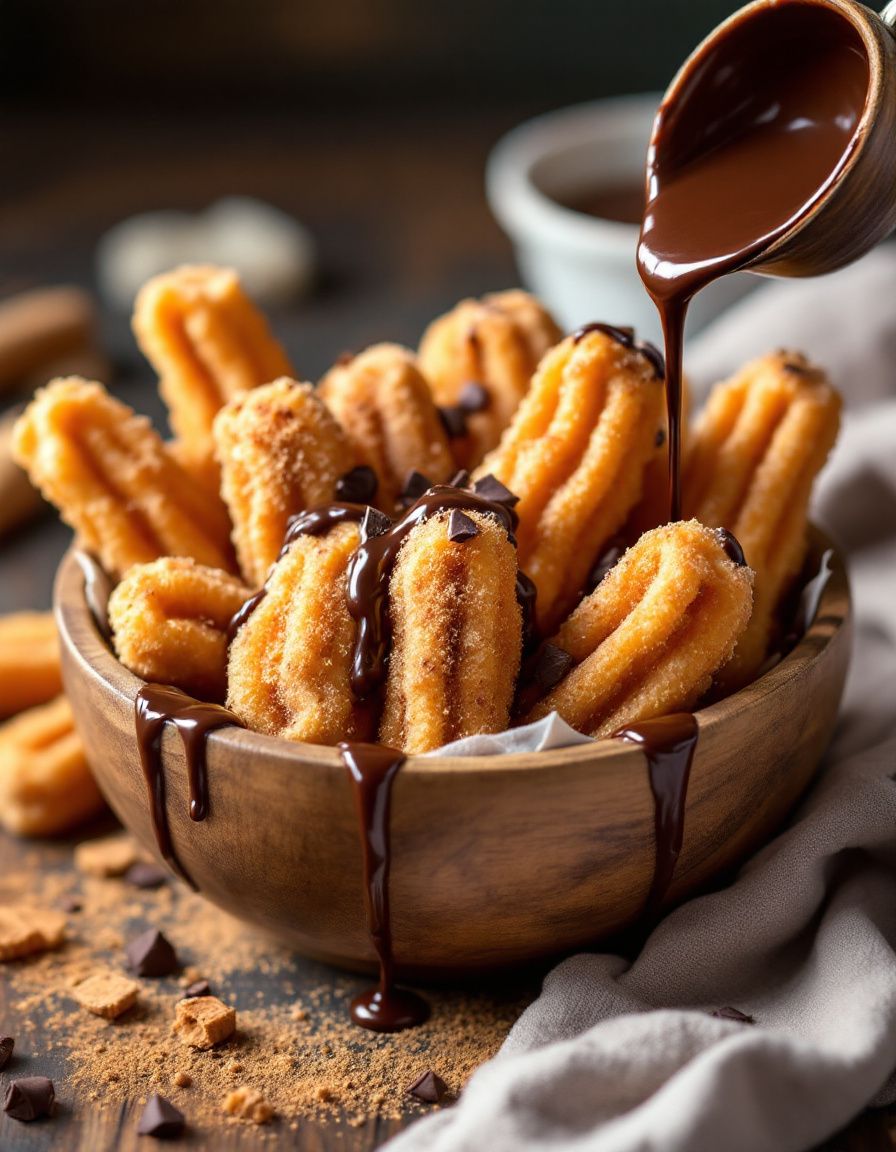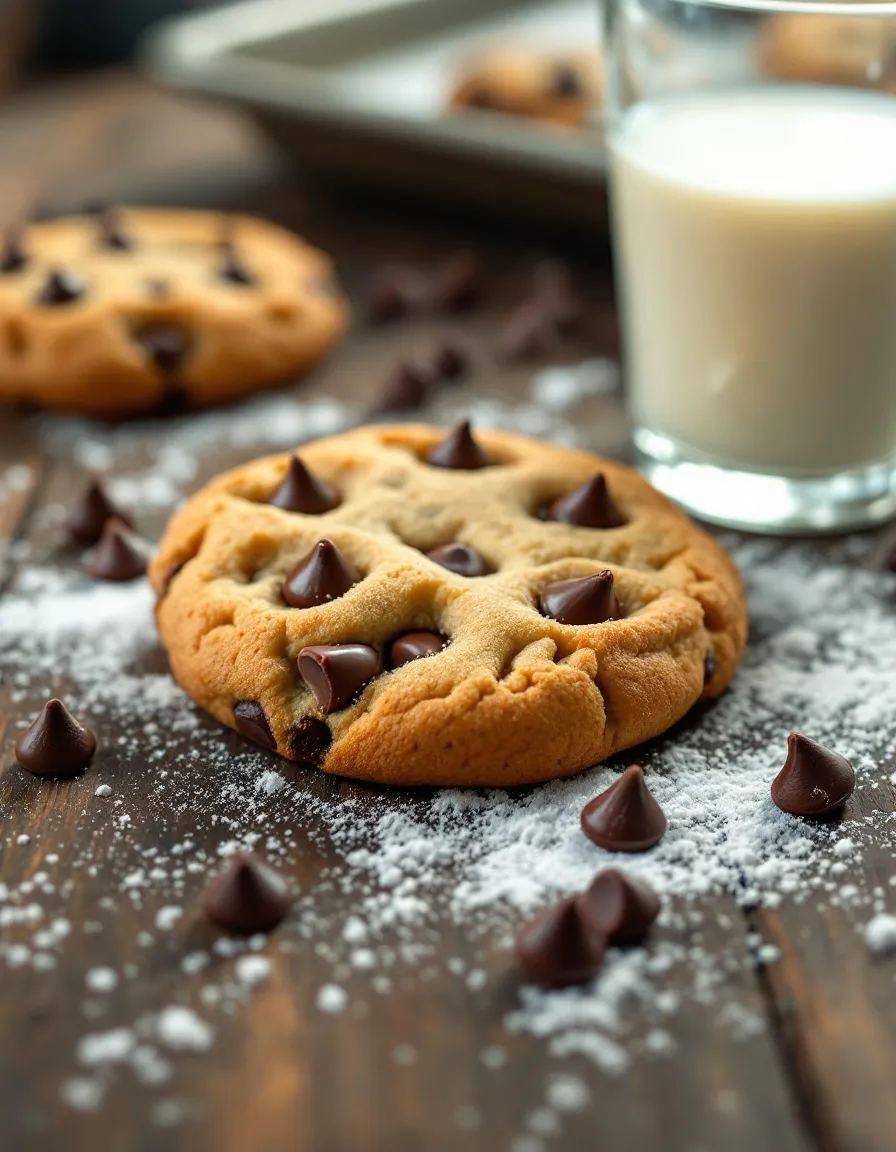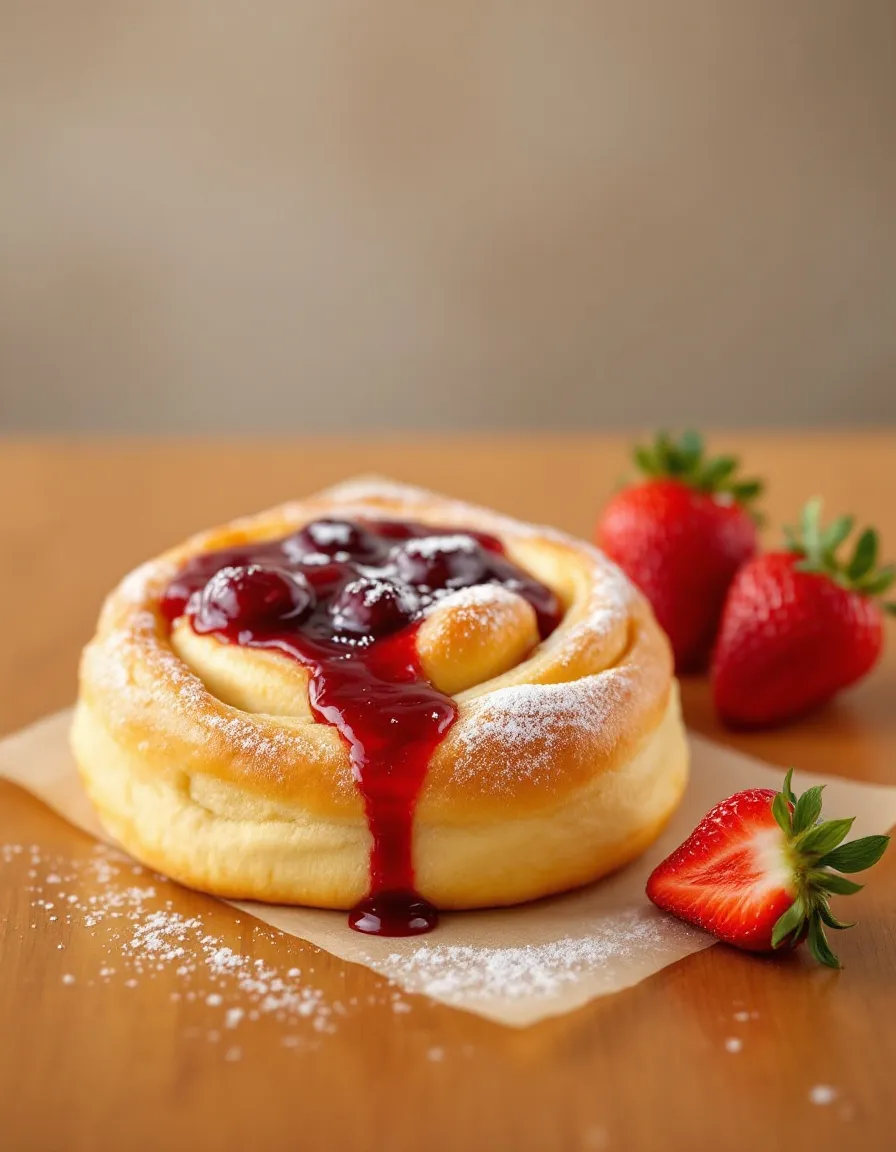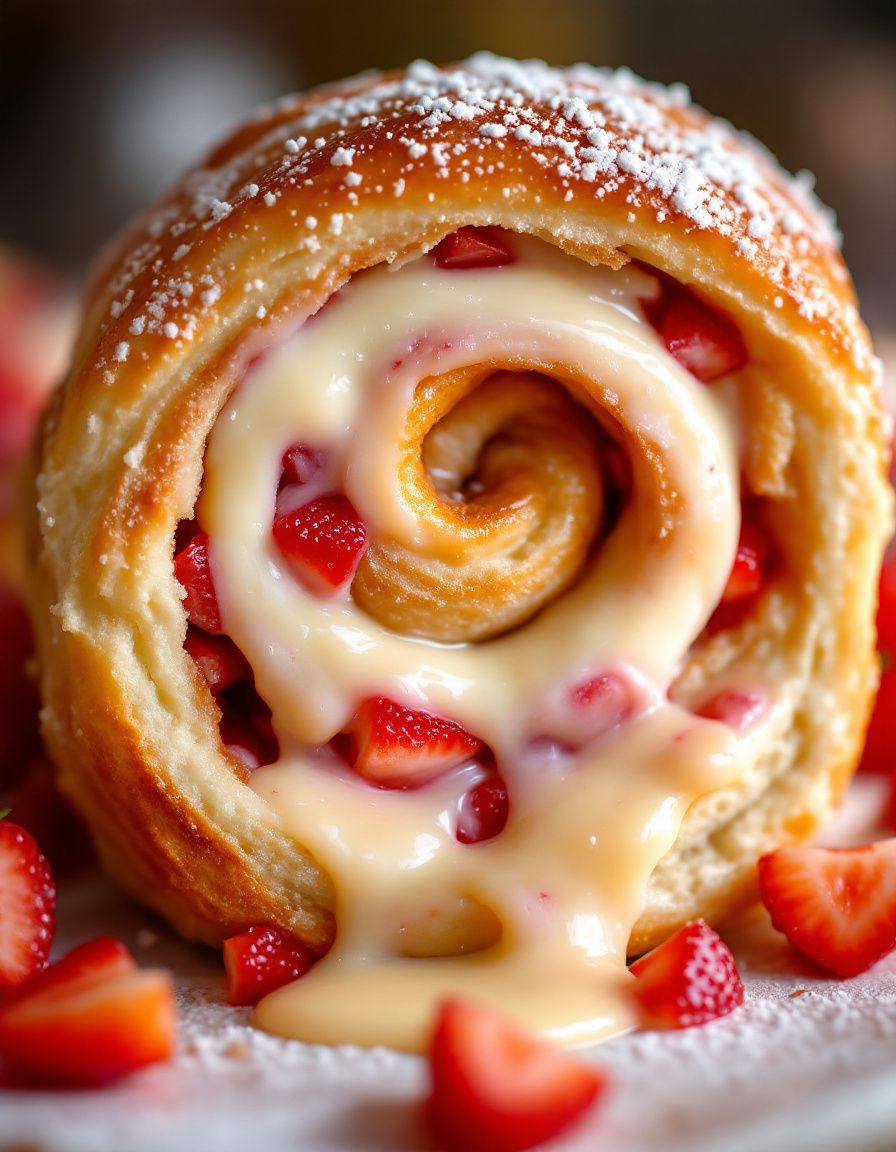Churros Bites: Irresistible Treats with Chocolate Dipping Sauce
Churros bites are a delightful twist on the traditional Spanish pastry. These bite-sized treats are crisp on the outside while being soft and fluffy on the inside, perfect for satisfying your sweet cravings. The churros are rolled in cinnamon sugar and served with a rich and velvety chocolate dipping sauce that adds an indulgent touch. Whether enjoyed as a dessert, a snack, or a fun treat for a party, churros bites are guaranteed to steal the show.
The beauty of churros bites lies in their versatility. They can be made fresh and served warm, making them an excellent choice for any occasion. With minimal ingredients and simple preparation, these delicious little pastries can easily become a staple in your dessert repertoire. The combination of sugar and spice is sure to make every bite heavenly.
Quick Recipe Highlights
- Flavor Profile: The churros have a sweet, buttery flavor accented by cinnamon, while the chocolate sauce adds a rich, decadent layer.
- Texture: These treats feature a crispy exterior that gives way to a tender, airy interior, complemented by the smooth chocolate sauce.
- Aroma: The warm scent of fried dough mingled with the sweetness of cinnamon creates an irresistible aroma in your kitchen.
- Visual Appeal: Golden brown churros bites dusted with cinnamon sugar contrast beautifully with the glossy dark chocolate sauce.
- Skill Level Needed: This recipe is beginner-friendly, making it easy for everyone to join in and whip up these delightful treats.
- Special Equipment: A piping bag will help shape the churros, making the process even simpler and more fun.
Recipe Overview
- Difficulty Level: The churros bites are easy to prepare, requiring only a few basic techniques like mixing, piping, and frying.
- Category: This dessert is perfect for gatherings, family snacks, or as a sweet ending to a dinner party.
- Cuisine: Originating from Spanish cuisine, churros have become popular worldwide and are loved for their unique flavor and texture.
- Cost: This recipe is cost-effective, with minimal ingredients that are affordable and easy to find in any grocery store.
- Season: Churros are delightful year-round but are particularly popular during festive occasions and holidays.
- Occasion: Serve churros bites at birthday parties, holiday gatherings, or simple family get-togethers for a special treat.
Why You’ll Love This Recipe
These churros bites offer a magical combination of flavor and texture that makes them irresistible. The crispy coating contrasts wonderfully with the tender inside, creating an experience that is both satisfying and comforting. The cinnamon sugar adds warmth and sweetness, while the rich chocolate dipping sauce elevates the entire experience.
Convenience is another reason to adore this recipe. With straightforward preparation and frying, there’s little fuss involved in making these enticing bites. They can be whipped up quickly, making them an easy option for unexpected guests or cravings. Plus, the recipe can be made in advance and enjoyed fresh, or even reheated without losing that deliciousness.
Nutritionally, churros bites should be enjoyed in moderation as they are a treat. However, when made at home, you can control the ingredients, ensuring they are made with high-quality products free from preservatives.
Social gatherings become even more enjoyable with these churros bites. They’re perfect for sharing and can be presented beautifully on platters, encouraging people to mingle. Their appeal is universal, making them a hit at any event.
Lastly, this recipe is accessible and budget-friendly. With only a few pantry staples needed, churros bites can be made without breaking the bank, allowing you to indulge in a delicious treat on a budget.
Historical Background and Cultural Significance
Churros have centuries of history that trace their origins to Spain, where they were a popular breakfast item for farmers. Traditionally, they were served with hot chocolate for dipping, creating a classic combination that has stood the test of time. Over the years, churros have made their way into many cultures, including Latin American countries where they are often enjoyed as street food.
The cultural significance of churros is significant in Spanish-speaking countries, where they frequently appear in festivals and celebrations, symbolizing camaraderie and festivity. Many cities, such as Madrid and Barcelona, have their iconic churro shops that draw both locals and tourists alike.
As the recipe for churros evolved, variations began to emerge, incorporating different flavors and styles. In Latin America, some regions have adopted fillings, such as dulce de leche or chocolate, creating unique versions of this beloved treat.
Today, churros are recognized around the globe and can be found in various forms, from the classic shapes to innovative bites. This evolution attests to their lasting popularity and cultural impact across generations and borders.
Ingredient Deep Dive
Flour
Flour is the fundamental ingredient in churros that provides structure and support. Using all-purpose flour is common, which lends itself well to achieving that perfect chewy texture. It’s important to sift the flour to avoid any lumps and ensure a smooth batter. For those considering gluten-free options, substitutes like almond flour can be utilized, but they may require additional adjustments to achieve the desired texture.
Sugar
Sugar is what makes churros deliciously sweet. Granulated sugar is typically used for the dough, while a blend of granulated sugar and cinnamon coats the exterior. The sweetness is crucial to balancing the flavors and adds to the appearance of the churros. For health-conscious individuals, consider using stevia or coconut sugar as alternatives for a lower glycemic index.
Common Mistakes to Avoid
- Not measuring ingredients accurately can lead to incorrect dough consistency, affecting the final product.
- Failing to heat the oil to the proper temperature will result in greasy or unevenly cooked churros.
- Skipping the resting period for the dough may prevent it from achieving the right texture when frying.
- Piping the dough too thick can lead to uneven cooking, resulting in a doughy center.
- Overcrowding the frying pan can lower the oil temperature significantly, leading to soggy churros.
- Not rolling the churros in cinnamon sugar immediately after frying can make it stick to the surface, resulting in uneven coating.
- Using a low-quality chocolate for the sauce can compromise the richness and flavor of the dipping experience.
- Not allowing the churros to cool slightly before serving can result in burnt tongues. It’s best to wait just a moment!
Essential Techniques
One key technique for creating churros is the proper method of frying. Frying the churros at the right temperature is essential to achieve the ideal texture: golden and crispy on the outside while remaining fluffy on the inside. Use a candy thermometer to monitor the oil temperature, aiming for around 350°F (175°C).
Mastering the piping technique is also crucial for uniform churros. Using a large star-shaped piping tip creates the classic ridged surface that holds the cinnamon sugar well. Pipe the dough into straight lines or shapes, depending on your preference, but avoid lifting the piping bag too much to prevent air bubbles.
Pro Tips for Perfect Churros Bites
To ensure your churros bites turn out perfectly, always pipe the dough directly into hot oil to maintain its shape and structure. Use a sturdy piping bag for easy control and avoid any mess.
Keep an eye on the frying time, ensuring each batch is cooked to a golden brown without burning. Make sure to let the churros rest on paper towels after frying to remove excess oil.
Experiment with different spice blends in the sugar coating, adding nutmeg or cayenne for a twist on the classic flavor.
Enjoy churros bites warm from the fryer, as that is when they are at their best. Reheat leftover churros by placing them in a preheated oven to restore their crispiness.
Serving churros with a variety of sauces, like caramel or flavored pastry creams, can create an exciting tasting experience for everyone.
Consider using a blend of dark and milk chocolate for the dipping sauce, as this creates a balanced flavor without being overwhelming.
Brushing the churros lightly with melted butter before rolling them in sugar enhances the flavor and helps the spice mixture adhere better.
Variations and Adaptations
Churros bites can be adapted in various ways to cater to personal preferences. One popular variation includes adding a filling, such as chocolate or cream cheese, to the center of the churros. This creates a delightful surprise with each bite.
Seasonal adaptations are also possible. For example, pumpkin spice can be used in the sugar mixture during the fall, recruiting a warm, comforting flavor profile. Similarly, during holiday seasons, incorporating peppermint extract into the chocolate dipping sauce can create a festive treat.
Dietary modifications can make churros bites accessible to various diets. Gluten-free churros can be made using almond flour or gluten-free flour blends. Vegan options can replace eggs with flax seeds or a commercial egg substitute, ensuring everyone can enjoy these delightful treats.
Flavor variations can include adding citrus zest to the batter or infusing the chocolate dipping sauce with liqueur for a gourmet twist. Different textured modifications, such as filling time, can offer new experiences and elevate traditional churros to a new level.
Serving and Presentation Guide
When serving churros bites, presentation plays a vital role in elevating the dining experience. Consider plating churros upright in a decorative jar or cone for a fun, rustic aesthetic. Use a small bowl for the chocolate dipping sauce, garnished with chocolate shavings or a sprinkle of cinnamon for added appeal.
For garnishing ideas, a dusting of powdered sugar can add an element of elegance. A drizzle of caramel sauce alongside the chocolate can also provide an inviting visual that encourages tasting.
Traditionally, churros are served warm, as the texture and flavor are optimal at this temperature. However, they can also be enjoyed at room temperature for ease of serving in casual settings.
Portion control is important, especially when serving at parties. Individual servings can be prepared in smaller portions or given as favor bags. This approach not only emphasizes shareability but also encourages guests to try various flavors and dips.
Wine and Beverage Pairing
For a delightful pairing with churros bites, consider serving a sweet dessert wine like a late harvest Riesling or a sparkling Moscato. These wines offer a balance that complements the sugar and cinnamon flavor of the churros.
For non-alcoholic alternatives, hot chocolate is a classic choice that aligns perfectly with churros. The richness of creamy hot chocolate makes each bite even more luxurious.
Additionally, coffee lovers may appreciate bold espresso or a smooth cappuccino for dipping churros, providing an invigorating contrast to the sweetness.
Temperature considerations are also vital; ensure beverages served alongside churros bites are at optimal serving temperatures to enhance the overall experience.
Storage and Shelf Life
To maintain the freshness of your churros bites, they should be stored in an airtight container at room temperature. This will help preserve their texture, preventing them from becoming soft or chewy.
Leftover churros can last for 1-2 days at room temperature. For longer storage, consider freezing them. Store cooled churros in a freezer-safe container, ensuring they are wrapped tightly to avoid freezer burn.
When reheating, place frozen churros in a preheated oven at 350°F (175°C) for about 10 minutes, or until warmed through. Avoid using the microwave, as it can make the churros soggy.
Signs of spoilage typically include an off smell or changes in texture. If churros feel particularly soft or moist after a few days, it’s best to discard them to ensure safety.
Make Ahead Strategies
If preparing churros bites for a gathering, consider making the dough in advance and refrigerating it. This allows the flavors to deepen, and the dough will be ready to pipe and fry when you need them.
You can also pre-make the chocolate dipping sauce and store it in an airtight container in the refrigerator. Simply reheat it in a microwave or on the stovetop before serving to achieve a smooth consistency.
In terms of assembly, churros should be fried just before serving to ensure they maintain their crispy texture. Keep fried churros warm in a low oven until it’s time to serve, allowing you to prepare everything else beforehand.
Fresh elements can be added just before serving, such as a sprinkle of cinnamon sugar to revive the churros’ flavor and visual appeal.
Scaling Instructions
When scaling the churros recipe, simply double or triple the ingredient measurements according to the number of servings desired.
For halving the recipe, be cautious with cutting the cooking times, as smaller batches can cook faster. Maintaining consistent frying temperatures is crucial to ensure even cooking.
If altering quantities, consider the size of your kitchen equipment. A larger pot may be required for frying if making bigger batches to avoid overcrowding.
Keep in mind that timing may change when scaling. Monitor the churros closely to avoid overbrowning or undercooking.
Lastly, adjust your storage needs accordingly based on the new quantities. Prepare for more airtight containers to preserve freshness.
Nutritional Deep Dive
When considering the macros for churros bites, a typical serving includes carbohydrates from flour and sugar, making them a source of energy. The amounts can vary based on the recipe and portion size.
Micronutrient analysis shows that churros may provide some vitamins from eggs if included. However, they are primarily a treat and should be enjoyed in moderation.
Churros offer unique health benefits if made with whole grains or less sugar. By making smart ingredient choices, this classic treat can be adapted to better suit dietary needs.
Dietary considerations may take into account the consumption of fried foods. It’s best to balance churros with healthier meals throughout the day.
Weight management tips can include portion control, as enjoying smaller servings can satisfy cravings without overindulging.
Dietary Adaptations
For those following a gluten-free diet, churros can be successfully made using almond flour or a gluten-free flour blend. Adjustments may be needed for texture and moisture.
Dairy-free adaptations can be achieved by substituting milk with almond milk or coconut milk in the chocolate dipping sauce, ensuring all guests feel included.
Vegan modifications involve replacing eggs with a flaxseed mixture, allowing vegans to enjoy the sweetness of churros bites without sacrificing flavor.
Making churros bites low-carb often involves using almond flour and a sugar substitute, creating a delicious option for those following Keto or Paleo diets.
Low-FODMAP diets may be accommodated by focusing on gluten-free flour and avoiding added high-FODMAP ingredients in the chocolate sauce.
Troubleshooting Guide
Texture issues can often arise from not following the correct frying temperature. Over or under-frying can lead to churros that are either too crunchy or not cooked properly.
Flavor balance can be affected by excess cinnamon sugar coating. Using just enough to dust the outside enhances flavor without overwhelming the palate.
Temperature problems in frying can arise from too many churros cooking at once, leading to uneven temperatures. Always fry in smaller batches to maintain consistency.
Equipment challenges may emerge when using a low-voltage fryer. Ensure you’re using reliable tools that can maintain high temperatures to achieve the ideal churros.
Ingredient substitutions may alter the outcome if not chosen correctly. Stick to similar textures and moisture levels when altering key ingredients.
Timing concerns can affect both preparation and frying steps, as churros left in hot oil too long can become overly browned. Keeping a close eye on cooking times is essential.
Recipe Success Stories
Community feedback about churros bites often highlights their easy preparation and delightful flavor. Readers frequently share pictures of their churros, emphasizing their golden color and perfect texture.
Variation successes shine a light on innovative takes on the classic recipe. Many people have experimented by infusing unique flavors in the chocolate sauce or adding fillings, leading to delicious results.
Adaptation stories highlight how families have incorporated churros bites into special gatherings, making them a staple for celebrations. These moments create lasting memories as everyone enjoys the sweet treat.
Reader suggestions often lead to creative modifications, enhancing traditional recipes. Some have suggested alternate dipping sauces, sparking excitement among churros enthusiasts.
Photography tips encourage sharing pictures of the churros bites, capturing their charm and appeal, helping to inspire others to try the recipe themselves.
Frequently Asked Questions
A: While the churros are best enjoyed fresh, you can prepare dough in advance and refrigerate it. Fry them right before serving for the best texture.
Q: What is the best way to reheat churros?
A: To reheat churros, preheat your oven to 350°F (175°C) and bake them for about 10 minutes until warmed through for the best crispiness.
Q: Are churros gluten-free?
A: Traditional churros are not gluten-free, but you can use gluten-free flour alternatives to create a delicious version that meets dietary needs.
Q: How can I make vegan churros?
A: Vegan churros can be made by replacing eggs with flaxseed meal mixed with water and using plant-based alternatives in the dipping sauce.
Q: What type of chocolate is best for dipping sauce?
A: A combination of dark and milk chocolate often strikes the perfect balance, providing a rich yet sweet flavor that pairs beautifully with churros.
Q: Can I freeze churros?
A: Yes, churros can be frozen. Allow them to cool completely, store them in an airtight container, and enjoy them later by reheating in the oven.
Q: How do I avoid greasy churros?
A: To avoid greasy churros, ensure the oil is at the correct temperature before frying, and do not overcrowd the pan while cooking.
Q: What can I use instead of cinnamon?
A: If you prefer alternatives, consider using nutmeg or pumpkin spice for a different flavor profile in your sugar coating.
Q: How long do churros stay fresh?
A: Churros are best consumed within a couple of days; after that, they may lose their crispiness and flavor.
Q: What other sauces can I use for dipping?
A: Churros can be paired with various dipping sauces, such as caramel sauce, dulce de leche, or even fruit preserves for a twist.
Additional Resources
For those interested in enhancing their churros experience, check out related recipes such as Mexican hot chocolate or different ideas for sweet dips.
Technique guides on frying and piping can further improve your cooking skills while also ensuring your churros turn out perfectly each time.
Ingredient information on key components used in churros can deepen culinary understanding and influence future flavors.
Lastly, equipment recommendations will help make your churros journey more accessible, offering choices to aid your success.
Join the Conversation
We invite you to share your churros bites creations on social media, showing off your delicious results and engaging with fellow cooking enthusiasts. Share your photography tips or tag your favorite variations to inspire others in the community.
Your recipe reviews and comments provide valuable feedback and encourage others to try their hand at making churros bites. Join the discussion about favorite fillings or sauces, creating a dialogue around this beloved treat.
Let’s celebrate the joy of cooking together, diving into diverse adaptations, and learning from each other’s cooking experiences!
The Recipe
Churros Bites with Chocolate Dipping Sauce
Serves: 4 servings
Prep Time: 20 mins
Cook Time: 10 mins
Total Time: 30 mins
Kitchen Equipment Needed
- Large pot for frying
- Candy thermometer
- Piping bag with star tip
- Mixing bowl
- Slotted spoon
- Paper towels
Ingredients
- 1 cup water
- 1/2 cup unsalted butter
- 1 cup all-purpose flour
- 1/4 teaspoon salt
- 2 large eggs
- 1 teaspoon vanilla extract
- 1 cup granulated sugar (for coating)
- 2 teaspoons ground cinnamon (for coating)
- 1 cup semi-sweet chocolate chips (for dipping sauce)
- 1/2 cup heavy cream (for dipping sauce)
Directions
- In a saucepan, combine water and butter and bring to a boil over medium heat.
- Once boiling, stir in flour and salt, mixing until a dough forms and pulls away from the sides of the pan.
- Remove from heat and allow to cool slightly. Add eggs one at a time, mixing well after each addition. Stir in vanilla extract.
- Heat oil in a large pot to 350°F (175°C).
- Transfer dough to a piping bag fitted with a star tip and pipe 4-inch strips into the hot oil, frying until golden brown on both sides.
- Remove churros and let them drain on paper towels. Mix sugar and cinnamon in a shallow dish and roll the warm churros in the mixture until coated.
- For the chocolate dipping sauce, heat heavy cream in a saucepan over medium heat and pour over chocolate chips in a bowl. Stir until melted and smooth.
- Serve churros bites warm with the chocolate dipping sauce on the side.
Recipe Notes
- For a unique twist, try adding orange zest to the churros dough.
- Substitute chocolate with white chocolate or caramel for varied dipping sauces.
- Serve with fresh fruit for a refreshing contrast.








